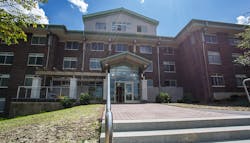SUNY New Paltz is renaming 6 buildings that carried slaveowner names
Six buildings at State University of New York at New Paltz, all of which were named for slave owners, will be renamed in time for the start of the fall semester.
The New York Times reports that the decision by SUNY New Paltz follows a recent wave of colleges grappling with troubling histories. Some schools have started projects specifically to explore their ties to slavery, publishing the findings online.
The SUNY Board of Trustees approved these name changes for facilities at SUNY New Paltz:
- Bevier Hall will become Minnewaska Hall
- Crispell Hall will become Ashokan Hall
- Deyo Hall will become Awosting Hall
- Dubois Hall will become Mohonk Hall
- Lefevre Hall will become Shawangunk Hall
- Hasbrouck Dining Hall will become Peregrine Dining Hall
- The Hasbrouck Complex, which consists of all six buildings, will become the Peregrine Complex
The chairman of SUNY’s Board of Trustees, H. Carl McCall, a former state senator and comptroller who was New York’s first black candidate to be elected to statewide office, applauded the decision by SUNY New Paltz to remove the slave owners’ names.
The school’s president, Donald P. Christian, says his decision to initiate the conversation that led to a recent vote grew out of the deadly 2017 “Unite the Right” rally of white supremacists in Charlottesville, Va. The rally began on the campus of the University of Virginia as part of a protest over a plan to remove a statue of a Confederate general from a city park.
“The fact that these names were on residential buildings was one that we heard a lot from students—what it meant for them to be asked to live and eat and sleep in buildings that carried the names of slave owners,” Christian says.
The SUNY New Paltz campus has about 7,500 students; about 6 percent are black.
After Charlottesville, Christian asked the community’s opinion about the dining hall and five residence halls that were namesakes of slave owners.
The school established a diversity panel that held public forums, examined how other institutions handled similar issues and researched local history.
The panel ultimately recommended the name change, a decision that deeply offended some descendants of the founders.
About the Author
Mike Kennedy
Senior Editor
Mike Kennedy, senior editor, has written for AS&U on a wide range of educational issues since 1999.
